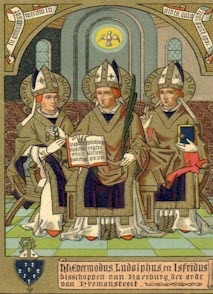Ludolph of Ratzeburg | |
|---|---|
 | |
| Bishop of Ratzeburg | |
| Died | 1250 |
| Venerated in | Catholic Church |
| Feast | 29 March |
Ludolph of Ratzeburg was a Premonstratensian Bishop of Ratzeburg.
Ludolph of Ratzeburg | |
|---|---|
 | |
| Bishop of Ratzeburg | |
| Died | 1250 |
| Venerated in | Catholic Church |
| Feast | 29 March |
Ludolph of Ratzeburg was a Premonstratensian Bishop of Ratzeburg.
In 1236, Ludolph was appointed to the see of the newly formed Prince-Bishopric of Ratzeburg. Ludolph came into conflict with Duke Albert I of Saxony and was duly imprisoned, where he was badly beaten, and later sent into exile. In exile Ludolph was taken in by Duke John of Mecklenburg, but died soon after in 1250 because of the abuse he received in prison. [1]
One legend tells of a soldier who was wounded when an arrowhead was embedded in his head. The soldier, who was in great pain, invoked the intercession of St. Ludolph, and he was soon able to remove the arrow and was healed. [2]